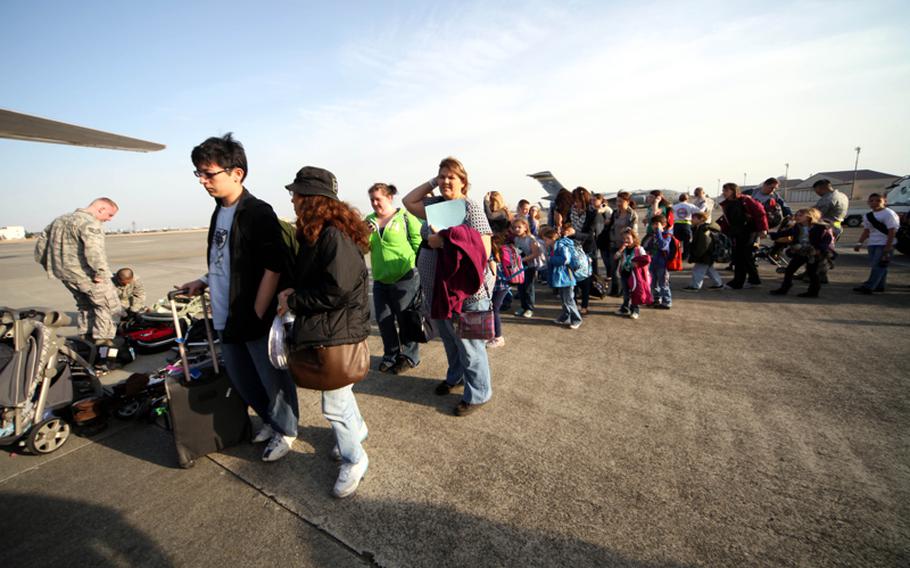
Following the quake and tsunami that hit Japan on March 11, U.S. military family members board a flight from Yokota Air Base, Japan, bound for to Seattle. (Grant Okubo/Stars and Stripes)
YOKOSUKA NAVAL BASE, Japan — The State Department has lifted its voluntary authorized departure order for U.S. government family members in Japan, according to an U.S. Embassy Tokyo announcement Friday.
The decision clears the way for the Defense Department to recall the thousands of family members that left Japan last month on military-assisted flights as part of its voluntary departure program.
U.S. Forces Japan officials said Friday afternoon that they expected an announcement on the status of Defense Department family members in the near future.
Military commands in Japan have been drafting guidance for families in anticipation of the order being lifted, but won’t finalize and release the information until they receive orders from the Pentagon.
“Family members will soon receive instructions on how to obtain return flights and proceed from their selected locations,” according to a statement from U.S. Forces Japan. “We want to ensure the process goes as smoothly as possible for our family members and are working to reunite them with their loved ones as soon as we can.”
On March 16, the State Department authorized paid flights for family members of U.S. government employees because of radiation fears surrounding the damaged nuclear reactors at the Fukushima Dai-ichi power plant. The next day, the military announced the same measure for family members at military bases on Japan’s main island of Honshu.
Somewhere between 9,000 and 10,000 family members left for the United States and select Asian locations on military-issued orders, according to figures tallied by Stars and Stripes.
Families that left on orders received free flights, and are entitled them to paid lodging and a daily stipend for food and expenses. However, military officials told families that took the orders that they would not be allowed to return until the voluntary departure order was lifted.
Families that left Japan using their own funds have been allowed to return at any time.
The U.S. Embassy in Tokyo updated its travel alert to Japan to reflect the lifting of the order. The alert is available at http://japan.usembassy.gov/e/acs/tacs-alert20110415.html.
The alert stated that while the nuclear situation remains serious, it does not pose a significant risk to people outside a 50-mile radius of the power plant.
“We continue to recommend that U.S. citizens avoid travel within the 50-mile radius of the Fukushima Daiichi Nuclear Plant,” the travel alert states. “U.S. citizens who are still within this radius should evacuate or shelter in place.”
All U.S. military bases in Japan are well outside that radius. Most of the military’s bases on the island of Honshu are located south and west of Tokyo, which is about 150 miles from the damaged reactors. Misawa Air Base is about 250 miles north of the nuclear plant.
Radiation levels have not threatened human health at U.S. military bases since the March 11 earthquake and tsunami, military officials have said.
Nevertheless, various commands have issued cautions and recommendations since the nuclear crisis began.
U.S. Naval Hospital Yokosuka called military family members with children 5 years old and younger in March and early April, and suggested that the children leave the country out of an “abundance of caution,” families were told. If radioactive iodine levels spiked, there was concern that young children might suffer side effects from taking iodine pills, military officials later said.
On the morning of March 15, personnel at Yokosuka Naval Base and Naval Air Facility Atsugi were told to remain indoors, which was later changed to a recommendation that they limit outdoor activity. On March 22, elevated levels of radioactive iodine were found in the Tokyo water supply, but those levels quickly dropped to safe levels for infants. There have been no health warnings since then in Tokyo, and the water supplies have remained safe at military bases.
Although the nuclear crisis is now more stable and predictable, it is still far from over, said Tetsuo Ito, professor of radiation biology and director of the Atomic Energy Research Institute of Kinki University in Osaka.
The damaged reactors still lack a cooling system and pumping water into the plant is not a long-term solution, Ito noted.
“Although I do not expect another major explosion in future, the system has yet to be fully recovered,” Ito said. “It is like a severely ill patient that somehow stays alive, with a prediction that he won’t get worse than what he is now,” he said.
Chiyomi Sumida contributed to this story.